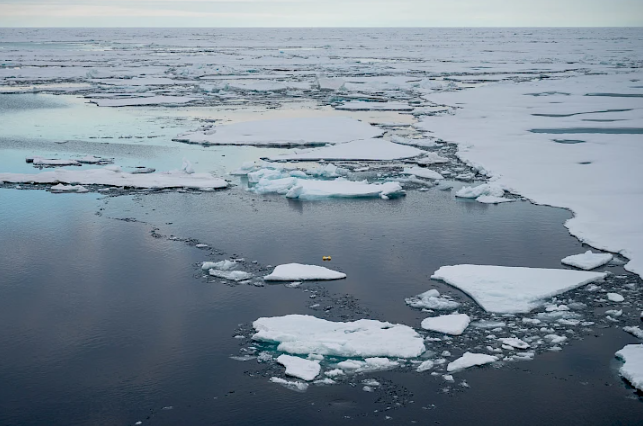
Northernmost "Plastic in a Bottle" launched at 84 degrees
To gain insight about Arctic marine plastic pollution, the Arctic Council’s Protection of the Arctic Marine Environment (PAME) Working Group is launching GPS-equipped capsules into the ocean to track how plastics move into and out of Arctic waters. Called “Plastic in a Bottle,” the project aims to simulate how marine litter and plastics can travel far distances and gain a better understanding of Arctic marine plastic pollution.
The latest Plastic in a Bottle launch is the seventh capsule released since the project started in 2019, and the first one launched around sea ice. The capsule was tossed into the ocean at 84 degrees north during a research cruise for students and early career scientists by the Norwegian Polar Institute on the icebreaker RV Kronprins Haakon.
“According to our knowledge of the area, we anticipate the capsule will drift westward into the Fram Strait, and possibly reach Greenland or Iceland,” said Ole Arve Misund, Director of the Norwegian Polar Institute (2017-2023). “We will track its movements as it drifts along with the sea ice before it is released in the area of the Fram Strait where the ice is melting rapidly.”
Plastic debris can be found on Arctic beaches, in the water column, in sea ice, sediments and even in the bodies of Arctic birds and mammals.
Plastic in a Bottle is a way to help the public visualize how an item of trash – perhaps their water bottle left at a picnic or even on a tourist boat – can travel miles away and affect the marine environment. Elizabeth McLanahan, Director at NOAA and Vice-Chair of PAME.
“There are many ways that plastic can make its way into and around the Arctic, whether it’s from rivers, wind, ocean currents or other means,” said Elizabeth McLanahan, Director at NOAA and Vice-Chair of PAME, who was on board the research cruise and tossed the capsule into the sea. “Plastic in a Bottle is a way to help the public visualize how an item of trash – perhaps their water bottle left at a picnic or even on a tourist boat – can travel miles away and affect the marine environment.”

© JESSICA COOK / ARCTIC COUNCIL SECRETARIAT
The capsules are designed with a GPS transmitter that typically sends a signal every day, allowing PAME, researchers and the public to follow the bottle’s journey in real time through an online map on PAME’s website. However, the latest capsule’s proximity to sea ice may have hindered the solar-powered GPS. After its launch on 18 August, the GPS signal has gone quiet, indicating that the capsule may have quickly become embedded in sea ice without access to adequate sunlight. Only time – and perhaps the 2024 summer sea ice retreat – will tell when the GPS signal can be reached again.
Once the capsules have washed ashore, a message inside the capsule will instruct the finder what to do and who to contact. So far, two capsules launched off the western coast of Iceland and Svalbard respectively, have come to shore. Incidentally, both capsules washed ashore on the Isle of Tiree in Scotland.
Marine litter is one of the most pervasive problems affecting the marine environment globally...By launching the Plastic in Bottle capsules, we can gain a better understanding of the problem while raising awareness around marine litter and plastic pollution in the Arctic.Katrine Nissen, Chair of PAME
“Marine litter is one of the most pervasive problems affecting the marine environment globally, and yet so far our understanding of how plastics move within ocean currents is limited,” said Katrine Nissen, Chair of PAME. “Marine litter is a threat not only to marine species and ecosystems, but also to human health and livelihoods. By launching the Plastic in Bottle capsules, we can gain a better understanding of the problem while raising awareness around marine litter and plastic pollution in the Arctic.”
The “Plastic in a Bottle” project is one initiative PAME has undertaken to tackle marine litter and plastic pollution in the Arctic. PAME’s Regional Action Plan on Marine Litter in the Arctic is a comprehensive resource aimed at enabling the Arctic Council to take targeted and collective action to address this problem within the Arctic and contribute to awareness of the Arctic-specific impacts. The Plan outlines strategic actions to be taken in the Arctic and plays an important role in demonstrating Arctic States’ stewardship efforts towards reducing the negative impacts of marine litter on the Arctic marine environment.
PAME’s work on marine litter and plastics is influential in international and regional efforts to tackle plastic pollution. The Arctic Council Working Group is a partner in the second International Symposium on Plastics in the Arctic and Antarctic Region, taking place on 22-23 November in Reykjavik, Iceland.
 Arctic Council Working Group
Arctic Council Working Group